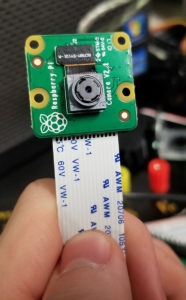Robotics Class Teaches Students Practical Skills
Robotics Class Teaches Students Practical Skills
Apr 25 2018 - 5:45pm
By: Gabrielle Behrens
Students in a robotics class at Southwestern Adventist University are turning an old automatic wheelchair into a self-moving robot as a class project.
Every year the CSIS 375 Introduction to Robotic Systems, taught by Dr. Daryl Thomas, has new students enrolled and a new project to complete. They learn skills that prepare the students for life beyond the university. This year the goal was to get an old automatic wheelchair to move on its own using lines of code the students have written.
The class has six students, who are all working toward completing a computer science degree. They are: Abdiel Rumaldo, Corey Hanson, Duke Nyabuto , Janelle Lo, Marty Dixon and Timothy Stowell.
[[{"fid":"21778","view_mode":"default","fields":{"format":"default","field_file_image_alt_text[und][0][value]":"computer science","field_file_image_title_text[und][0][value]":false},"type":"media","field_deltas":{"2":{"format":"default","field_file_image_alt_text[und][0][value]":"computer science","field_file_image_title_text[und][0][value]":false}},"attributes":{"alt":"computer science","style":"height: 254px; width: 300px;","class":"media-element file-default","data-delta":"2"}}]]
The students are attempting to making the old wheelchair autonomous. In layman’s terms: having the robot think for itself. The students are planning to accomplish this using a combination of sonar and cameras.
 “This is important, so it doesn’t crash into things,” says Dixon.
“This is important, so it doesn’t crash into things,” says Dixon.
They took out the wheelchair’s previous automatic system that made it moveable via a simple joystick a person sitting in the chair could control. With a final goal in mind of constructing their own system and making it autonomous, students have a lot of work to do to complete the project. The goal is to finish it before the semester ends. Then when new students take the course next year, they can potentially improve what has already be accomplished.
Students are learning many skills that will be valuable after college. As they work towards their goal, students have learned how to design models for a 3-D printer, build wiring from scratch, improve their mechanical skills and coding skills. Most importantly, they learn the value of design tradeoffs.
“Recognizing compromise is the first step in moving forward,” says Dixon. “It’s something Dr. Thomas emphasizes over and over again.”
“This is important because you don’t always have enough time, money, or even knowledge of certain types of software,” he continues. “Knowing how to use other equipment to do what you want is important.”
Having a positive attitude when going into territory you’re unfamiliar with is important. It is also important, to have clear understanding of the purpose of what you do. Knowing how to make compromises is a valuable life lesson. The purpose of the robotics class is not just to learn how to compromise but to build life skills.
“The goal of the class is to have students familiarize themselves with components of robotics and to give them an experience to build off of,” Thomas says. “This is not an advanced robotics class. But this class gives students the opportunity to know what robotics is and what goes into making a robot.”
[[{"fid":"21779","view_mode":"default","fields":{"format":"default","field_file_image_alt_text[und][0][value]":"computer science","field_file_image_title_text[und][0][value]":false},"type":"media","field_deltas":{"1":{"format":"default","field_file_image_alt_text[und][0][value]":"computer science","field_file_image_title_text[und][0][value]":false}},"attributes":{"alt":"computer science","style":"height: 322px; width: 200px;","class":"media-element file-default","data-delta":"1"}}]]
Cameras like these help prevent the robot from crashing into obstacles.